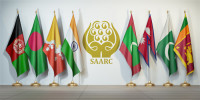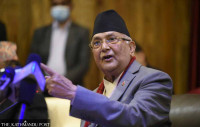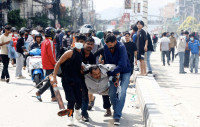Opinion
Another door opens
Hopefully, the quake will act as a catalyst to push for scientific studies in Nepal
Gyanendra Gurung
There is an urgent need to overhaul the current strategy of scientific research in Nepal—if it has one—in the aftermath of the recent Gorkha earthquake. For years, our nation adopted political and institutional mechanisms that were neither equipped to mitigate natural hazards nor were they able to prepare us for the inevitable earthquake. Take for example landslides. Every year, numerous landslides occur throughout the nation during the monsoon resulting in loss of lives and properties. Yet, nothing but fear and panic is offered to the public.
And, if we are to talk about the science, we were hardly able to scientifically quantify the causes of these landslides, and that was before the earthquake. Now, with the earth rattled and savaged by swarms of terror-triggering tremors, how confidently do we understand our hazardous environment to correctly forecast the number and distribution of various types of landslides that will be triggered during and in post-monsoon season? Will there be a surge of new landslides or will the old ones—such as the Jure landslide along the Araniko Highway—be re-activated again? These are among the many scientific riddles that we have yet to answer to the public.
Interdisciplinary approach
The understanding of the geophysical processes in the Himalayas, inspite of being a fertile ground for researchers all over the world,is in its infancy. There is plenty of scientific research that has been done and is being done in the Himalayas. However, many of these studies are guided along narrowly-focused objectives—answering directly to some client’s interest— and since natural disasters are multi-faceted problems, these studies may fail to fathom the reality that knowledge in more than one scientific discipline is essential in investigating the problem’s cause and effect. Thus, it is high time we find a way to tie together the complex geomorphological, hydrological, ecological, and other scientific aspects of the Himalayas into a single framework and develop an inter-disciplinary mode of study of our dynamic, but fragile ecosystem.
Let us take the example of the landslides again. From a broader inter-disciplinary point of view, landslides can be defined as a geophysical process intricately linked to the geomorphological, geological, structural, hydrological, climatological, and ecological environment in which they occur. That sentence alone will tell you how many different sets of data and experts we need to not just study a landslide, but to correctly identify the scientific thresholds that will distinguish a threatening from a non-threatening landslide. Moreover, if that landslide poses serious threats to a nearby human settlement, then we need to add a few more experts to take account of the sociological and economic impact as well.
So, which national agency will be best suited to take the lead in this inter-disciplinary research? Well, it would be great if a ‘Center of Excellence’ was created by the National Academy of Science and Technology—to oversee such an effort—with other academic institutions in collaboration with major government agencies that have active monitoring networks on natural hazards. The problems facing the Himalayas are manifold and such a union can draw from the vast pool of experts to design a research agenda that will address issues facing Nepal from its far-west corner to the east. And since our geoenvirontmental problems share their natural boundaries with the adjacent countries, transboundary and international cooperation must also be sought for exchange and transfer of scientific data and knoweldge.
Youth onboard
Building a healthy strategy will require a long list, which I cannot write about here due to lack of space. However, two things that the interdisciplinary body must do immediately are: build an initial national scientific database and offer scientific opportunties to the youth. The first step is easy but overwhelming. In order to remove redundancies and save time, we need to reach out to the research communities—both national and international—working either in Nepal or abroad, to share all significant information they have. We need to funnel all the fragmented research pieces together into a single collective national database. Through this, we will not only be able to identify gaps in our knowledge, but also finally be able to connect different studies done at different scales together, ie, from micro level (settlement), to meso (district), and to macro (national). With a single centre for dissemination and easy access to a much-needed scientific knowledge of varying resolution, engineers, planners, policymakers, and the public can then make quick and informed decisions that will be crucial in reducing disaster risk in the long run.
Of course not all of the data will be complete nor contemporary as our environment is dynamic, and it keeps changing both in space and time. Thus, the database needs updating and this will necessitate a massive deployment of scientific personnels spread all over Nepal on a regular basis. However, you might argue that we may not have enough professionals. But we do. We simply need to promote young enthusiastic students from various disciplines to engage in these new scientific endeavours, by offering academic scholarships. Not only will this fulfill the much-needed skilled technical expertise, but such active participation of the youth in a national programme will sow strong roots for sustainable development. How? Well, these very same students—armed with academic and scientific opportunties—will continue their education and research independently, and after establishing themseleves as experts, they will lead the very same research section in the future. So, if we can pave this promising path for a young student’s journey from an intern to an professional, then we can be assured that they will inevitably continue—and broaden—the scientific vision that our nation desperately needs.
High time
Our esteemed professors and veteren professionals will be pivotal to the success of this entire inter-disciplinary approach. Not only will they be responsible for providing scientific oversight of these ambitious reseach programmes, but their expertise and wisdom will be integral in formulating policies for politicians to act upon. They will provide impetus to the political dimension of the scientific problems of our nation.
Science hastens development, and like it or not, we need to convince politicians to support favourable policies that will promote scientific research and development for the betterment of our country. And, the ‘we do not have money’ is nothing but gibberish. If the government can allocate enough funds for politicians to buy luxury cars, then how can they not contribute a fraction of the sum to fundamental research? But, if we do fail—as we have done so in the past—to churn the political will for a scientific revival from our short-sighted politicians, then shouldn’t we instead harness the scientific will from our youth? The time is right, and the money is out there, and hopefully, this disaster will act as a catalyst for change and prepare Nepal for the scientific opportunities and challenges of the future.
Gurung is a Post-doctoral Research Fellow at Chonbuk National University, South Korea




 7.12°C Kathmandu
7.12°C Kathmandu










